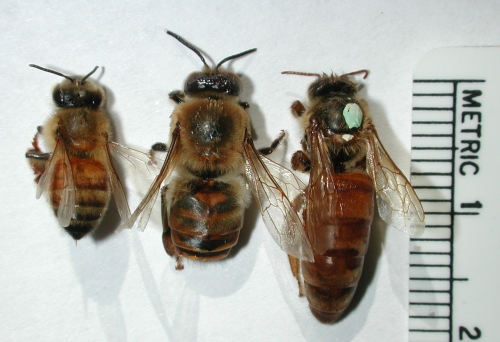On the surface the abdomen has no special outside structures, but is the center for digestion and reproduction (for drones and queens). It also houses the sting, a powerful defense against us humans.

Contents |
…
On the surface the abdomen has no special outside structures, but is the center for digestion and reproduction (for drones and queens). It also houses the sting, a powerful defense against us humans.

Contents |
…
As a member of the insect class (Insecta), honey bees share with other insects the following characteristics. Honey bees are segmented in nearly all their body parts: three segments of thorax, six visible segments of abdomen (the other three are modified into the sting, legs and antenna are also segmented. Honey bees have an exoskeleton, which …
Basic manipulation of a bee hive conforms to the seasonal cycle of bee biology. Beekeepers disrupt defensive behavior by application of smoke, assist bees in protecting against infection of diseases or predation by small and large predators, provide conditions for normal brood and population expansion and also ensure adequate space for storage of reserves necessary for winter survival. When all goes well, the beekeeper harvests the reserve stores leaving adequate food for daily maintenance and overwinter success.
The “key” to …
There are three development stages in bees which collectively are known as brood. Bees begin their life in the tiny white egg stage. A queen will deposit one egg in each worker or drone cell. The eggs are about the diameter of a pin and stand on end in their cells. They are very difficult to see. The eggs that will develop into workers are fertilized, while the eggs that will yield drones are not. We cannot tell …
Some of the major biological features that beekeepers need to understand are: basic bee nest ecology, the bee caste system, bee anatomy, the development of bee brood, worker bee sequence of duties, caste brood rearing/adult population seasonality, communication as a “key” to maintaining the social cohesion of the colony, queen and colony reproduction/replacement, and how to read/understand bee behavior/biology.
This page and the menu below is the online version of MAAREC’s fact sheet, “Basic Bee Biology for Beekeepers”. To …
Apis mellifera is a cavity nester. Understanding the basic nest ecology has led to an effective and efficient, man-made hive . the Langstroth hive. The natural or feral nest (and beekeeper hive) has these five features:
A tree cavity is a common nest site in the …
Workers do the work in the bee society. The figure below summarizes the phases of life of a worker bee. It is possible to identify a .rule of three,. such as three brood stages, three days as an egg, 2 X 3 days as larva, 3 X 4 days as pupa, three weeks as hive bees, three weeks as a field bee before death, etc. Workers generally start with hive duties like cleaning, feeding developing larva once hypopharyngeal glands develop, …
Understanding worker bee anatomy can help beekeepers understand bee biology. They are well equipped for life as social animals and to be successful in the environment.

Bees are well covered by branched (plumose) body hairs. They also have thousands of unbranched hairs covering their body which are for sensory purposes. …
Since there is only a single female reproductive in a bee colony, there is a special procedure to replace her when it becomes necessary to do so. Replacement of a queen by another queen is a process termed supersedure. Replacement of the queen and production of another colony is another behavior which is called swarming. A third means of replacing a queen, emergency queen rearing, is necessary if the queen dies suddenly, is removed by a beekeeper, …
The population of a bee hive fluctuates during the year according to the seasons and food resources. The queen usually lives for a couple of years (in temperate areas at least) and is replaced only during favorable resource [forage] conditions. The numbers of workers fluctuate considerably during the season. Drones are produced when resources improve in the spring and then eliminated in the fall — a seasonal pattern determined by resource availability.
In January and February, the worker adult population …